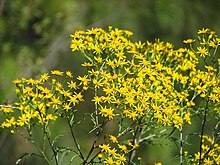Sessea is a genus of 19 accepted species of shrubs, small trees and climbers belonging to the subfamily Cestroideae of the plant family Solanaceae. The flowers of Sessea are so similar to those of Cestrum that the genera cannot usually be told apart, unless the plants are in fruit. Then their distinguishing characteristics become immediately apparent; plants of the genus Sessea bearing dehiscent capsules dispersing winged seeds, while those belonging to the genus Cestrum bear juicy berries containing prismatic seeds. The flowers of both Sessea and Cestrum have tubular corollas that are long exserted from small calyces.[1]
| Sessea | |
|---|---|

| |
| Sessea brasiliensis | |
| Scientific classification | |
| Kingdom: | Plantae |
| Clade: | Tracheophytes |
| Clade: | Angiosperms |
| Clade: | Eudicots |
| Clade: | Asterids |
| Order: | Solanales |
| Family: | Solanaceae |
| Subfamily: | Cestroideae |
| Tribe: | Cestreae |
| Genus: | Sessea Ruiz & Pav. |
Taxonomy
editThe genus commemorates Spanish botanist Martín Sessé y Lacasta, was described by Nicholas Edward Brown and was published in Florae Peruvianae, et Chilensis Prodromus 21,1794 by Hipólito Ruiz López and José Antonio Pavón Jiménez. The type species is: Sessea stipulata Ruiz & Pav.[2]
Species
edit- Sessea andina Francey
- Sessea brasiliensis Toledo
- Sessea colombiana Francey
- Sessea confertiflora Francey
- Sessea corymbiflora Goudot ex Rich. Taylor & R. Phillips
- Sessea crassivenosa Bitter
- Sessea dependens Ruiz & Pav.
- Sessea discolor Francey
- Sessea farinosa (Urb. & Ekman) Francey
- Sessea graciliflora Bitter
- Sessea herzogii Dammer
- Sessea macrophylla Francey
- Sessea multinervia Francey
- Sessea pedicellata Francey
- Sessea regnellii Taub.
- Sessea sodiroi Bitter native to Ecuador
- Sessea stipulata Ruiz & Pav.
- Sessea tipocochensis (Werderm.) Francey
- Sessea weberbaueri Bitter
Toxicity
editExperiments conducted in Pindamonhangaba between 1963-65, demonstrated the toxicity of Sessea brasiliensis on cattle. Symptoms of poisoning began approximately 12 hours after ingestion of the plant, consisting of apathy, anorexia, decreased intensity and number of rumen movements, muscle tremors, and unsteady gait. In total, three animals died during the experiments, two of which within 24 hours of the first symptoms.[6]
The study concluded that S. brasiliensis poisoning was very similar, or even identical, to that of Cestrum laevigatum; a species used to induce hallucinations by the Krahô tribe for spiritual purposes.[6] [7]
References
edit- ^ Benítez De Ro, Carmen and D'Arcy, William G.,"The Genera Cestrum and Sessea (Solanaceae:Cestreae) in Venezuela" Ann. Missouri Bot. Gard. 85: 273-351. 1998.
- ^ Forzza, R. C. 2010. Lista de espécies Flora do Brasil http://floradobrasil.jbrj.gov.br/2010. Jardim Botânico do Rio de Janeiro, Rio de Janeiro. Retrieved at 14.27 on 6/3/19.
- ^ https://bioweb.bio/galeria/FotoEspecimen/Sessea%20sodiroi/444258 Retrieved 11.24 on 5/3/19
- ^ Armando T. Hunziker: The Genera of Solanaceae. A.R.G. Gantner Verlag K.G., Ruggell, Liechtenstein 2001. ISBN 3-904144-77-4, pps. 38-41.
- ^ The Plant List http://www.theplantlist.org/tpl1.1/search?q=Sessea Retrieved 11.06 on 5/3/19.
- ^ a b "Poisoning by Sessea brasiliensis Toledo in cattle". Poisoning by Sessea Brasiliensis Toledo in Cattle. 1965.
- ^ Rodrigues, Eliana; Carlini, E.A. (2006). "Plants with possible psychoactive effects used by the Krahô Indians, Brazil". Revista Brasileira de Psiquiatria. 28 (4): 277–282. doi:10.1590/s1516-44462006000400006. PMID 17242806.